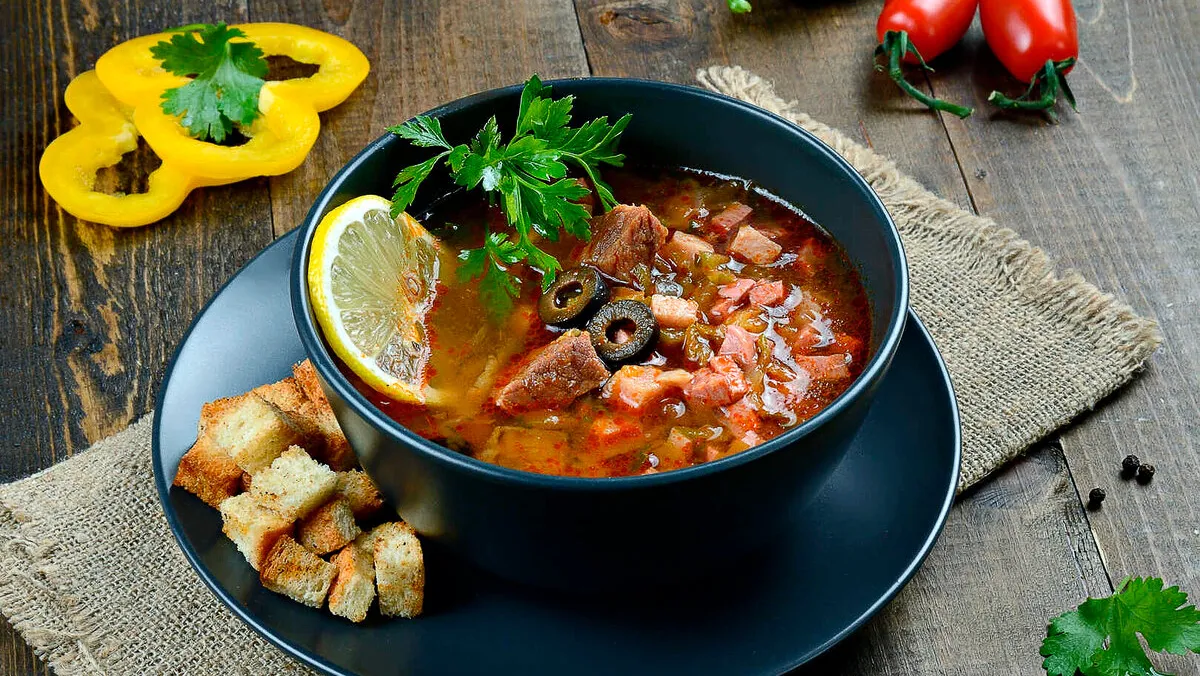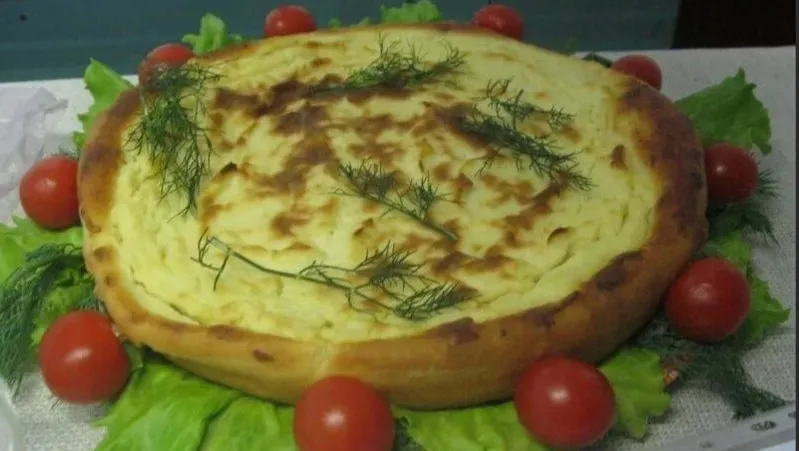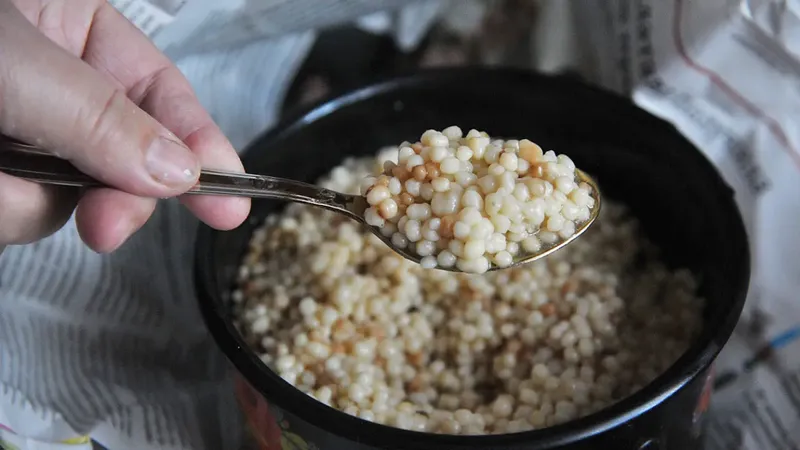Foreign tourists arriving in Russia often begin to explore Russian cuisine with this dish. "Solyanka" tastes so good! Their fame has spread worldwide. However, there have been disputes among scholars for over a century about the correct name of this dish and its origin. Here's what the poet and playwright Boris Timofeev wrote about it: "There is no such dish. And if you are offered "solyanka" (meat or fish) in a restaurant or canteen, know that it's a distorted word "selyanka," which comes from the word "selo," meaning village food." In one of M. E. Saltykov-Shchedrin's feuilletons "Gazetchik," it is said: "...you arrive at a Moscow tavern: "Gavrilo! Selyanka!" Oh, what a selyanka it was!"
However, the Soviet writer V. Belov believed that the origin of this word is different: "Selyanka resembled the so-called solyanka served in modern restaurants, very few in number. Even its name derived from the word "sel" (something thick, flowing), not from "salt" at all." Belov's assertion is probably not entirely correct, as the word "sel" comes from the Arabic "sayl" (stream), a term that was unlikely familiar to residents of Vologda.
There is also the opinion that the name of the dish - solyanka - means "mishmash", "confusion." Supposedly, in ancient times, during major holidays in villages, a "common" soup was prepared for all residents, with each person bringing the products they had. They were combined in one common pot, so it was difficult to determine what such a soup consisted of. It cannot be claimed that this belief is true, but even today Russian people call any mixture of different components "solyanka" ("mixed solyanka").
Interestingly, in the dictionary of the Russian Academy of Sciences for 1794, there is no entry for "solyanka," and the entry for "selyanka" is dedicated to a plant: "the succulent herbs growing by the seashore and on saline soils." The terms of interest to us are mentioned only in the entry for "salt": "Solyanka, in colloquial language, selyanka. A dish seasoned with sauerkraut, fish or beef, ham, vinegar, pepper. Solyanoshny and selyanoshny - belonging to solyanka, selyanka." The mention of the terms of interest to us in the entry for "salt" a priori makes selyanka dependent on solyanka, which leads to its interpretation as a distorted term. One might think that "solyanka," like the words "rassolnik," "rassolnoye," and "rassol," has a semantic connection with the lexeme "salt." At first glance, indirect confirmation of this is the fact that ordinary soups contain about 1% table salt, and only in shchi, prepared from sauerkraut, rassolniks, and selyankas, does its content reach 1.2-1.5%. However, on the other hand, it would be more correct to call selyanka "kislyanka," because it contains more acids than any other Russian soups.
Even more confusion in understanding the name of the dish is caused by the fact that selyanka can be not only a soup but also a hot snack based on sour or fresh stewed cabbage, served on a skillet before or after the soup, - before the meat dish.
If you study pre-revolutionary cookbooks, you can discover that until 1855, the dish "solyanka" is nowhere to be found, while "selyanka" is present. According to the texts, it was prepared in a skillet and served, depending on its contents, as a hot snack or as a second course. The selyanka of that time was based on sour or fresh cabbage, stewed with meat (or fish and caviar), seasoned with onions, usually pickles, sometimes pickled mushrooms, cherries, and apples. It is logical to assume that the name of the dish is somehow related to the main component of solyanka, namely cabbage, the names of which in Slavic languages are derived from the root *zelь: zéle (Bulgarian), zéљe (Serbian), zelí (Czech).
However, the word "solyanka" first appears in Russian cookbooks only in 1860, simultaneously as a snack and as a soup. Both dishes, in terms of technology and composition, were selyanka (in the soup version - diluted and harmonized with broth). Some authors, when providing a recipe for solyanka, call it selyanka. A.I. Toliverova in 1880 operates with the term "selyanka," and in 1908 - "solyanka." It can be said that until 1910, these two terms, denoting the same dish, were equal. Or almost equal, because more "academic" cookbooks (I.M. Radetsky, A. Makarova, P.P. Alexandrova-Ignatieva, etc.) preferred the term "selyanka."
Throughout the second half of the 19th century, selyanka changed and became more complex, turning from a fairly simple dish into a fantasy consisting of a large number of components. Tomatoes, gherkins, crayfish necks, cucumber brine, olives (olives), and capers (1880) appeared in it, carrots and white roots as a dressing for the soup (1880), potatoes (1902), meat and fish could be used in the soup simultaneously.
Until the October Revolution, solyanka was more of a tavern and restaurant dish rather than a homemade one. Moscow merchants specifically went to taverns for solyanka, for example, to the restaurant "Metropole." They served Polish, Warsaw, as well as meat, fish, and assorted solyankas there, and contemporaries understood their differences without explanations. Polish solyanka - with chicken knoedels and sturgeon head cartilage, sometimes with crayfish or sturgeon fillet, was invariably prepared on cucumber brine with tomato "color." Warsaw solyanka - simpler, with meat and chicken but without fish. Fish and meat solyanka without nationality indication differed in that all ingredients were initially boiled in one pot, while in Polish varieties, the stew fried in the end was dressed with broth. Finally, assorted solyanka. It was at the bottom of the "Metropole" menu, as it "collected" all possible types of meat and smoked products that were not in demand in the kitchen during the day. It's amazing, but the soup, which would later be called "royal" in emigrant Russian restaurants, began its career as a hodgepodge of scraps and leftovers, sold for a kopeck per bowl.
After the revolution, the technology of preparing solyankas began to simplify, and cookbooks began to openly write about the use of "leftovers from various roasts," i.e., solyanka in some way turned into an economical dish. People even started joking that Soviet chefs invented solyanka to dispose of leftovers.
Since the dissolution of the USSR, more than three decades have passed, but to this day, solyankas in the vast majority of restaurants are prepared quite poorly, especially because they not only contain second-rate raw materials (instead of sturgeon - scraps from sturgeon carcasses, head meat), but also are reheated multiple times, which practically leads to a complete loss of their delicate and original taste.



